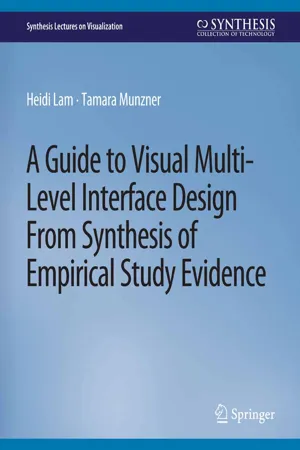
A Guide to Visual Multi-Level Interface Design From Synthesis of Empirical Study Evidence
- English
- PDF
- Available on iOS & Android
A Guide to Visual Multi-Level Interface Design From Synthesis of Empirical Study Evidence
About This Book
Displaying multiple levels of data visually has been proposed to address the challenge of limited screen space. Although many previous empirical studies have addressed different aspects of this question, the information visualization research community does not currently have a clearly articulated consensus on how, when, or even if displaying data at multiple levels is effective.To shed more light on this complex topic, we conducted a systematic review of 22 existing multi-level interface studies to extract high-level design guidelines. To facilitate discussion, we cast our analysis findings into a four-point decision tree: (1) When are multi-level displays useful? (2) What should the higher visual levels display? (3) Should the different visual levels be displayed simultaneously, or one at a time? (4) Should the visual levels be embedded in a single display, or separated into multiple displays? Our analysis resulted in three design guidelines: (1) the number of levels in display anddata should match; (2) high visual levels should only display task-relevant information; (3) simultaneous display, rather than temporal switching, is suitable for tasks with multi-level answers.Table of Contents: Introduction / Terminology / Methodology / Summary of Studies / Decision 1: Single or Multi-level Interface? / Decision 2: How to Create the High-Level Displays? / Decision 3: Simultaneous or Temporal Displays of the Multiple Visual Levels / Decision 4: How to Spatially Arrange the Visual Levels, Embedded or Separate? / Limitations of Study / Design Recommendations / Discussion and Future Work
Frequently asked questions
Information
Table of contents
- Cover
- Copyright Page
- Title Page
- Contents
- Acknowledgments
- Figure Credits
- 1 Introduction
- 2 Terminology
- 3 Methodology
- 4 Summary of Studies
- 5.1 Multi-level interface interaction costs should be considered
- 6 Decision 2: How to Create the High-Level Displays?
- 7 Decision 3: Simultaneous orTemporal Displays of the Multiple Visual Levels
- 8 Decision 4: How to Spatially Arrange the Visual Levels, Embedded or Separate?
- 9 Limitations of Study
- 10 Design Recommendations
- 11 Discussion and FutureWork
- A Reviewed Studies: Interfaces,Tasks, Data and Results
- Bibliography
- Authors’ Biographies